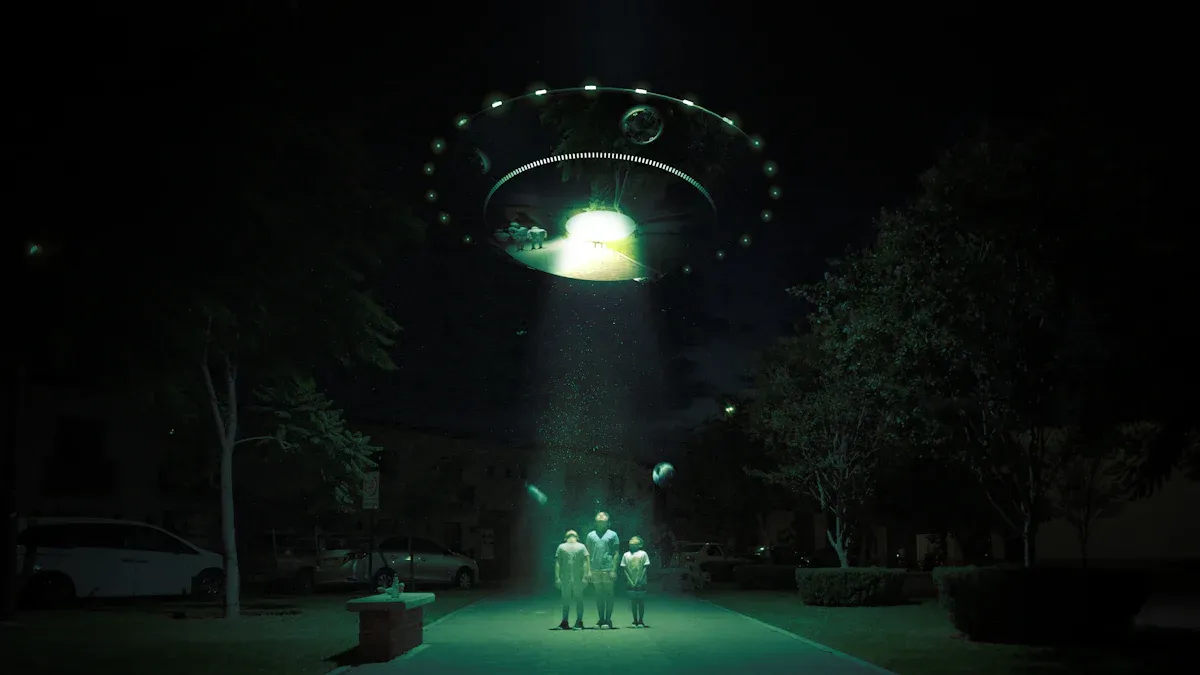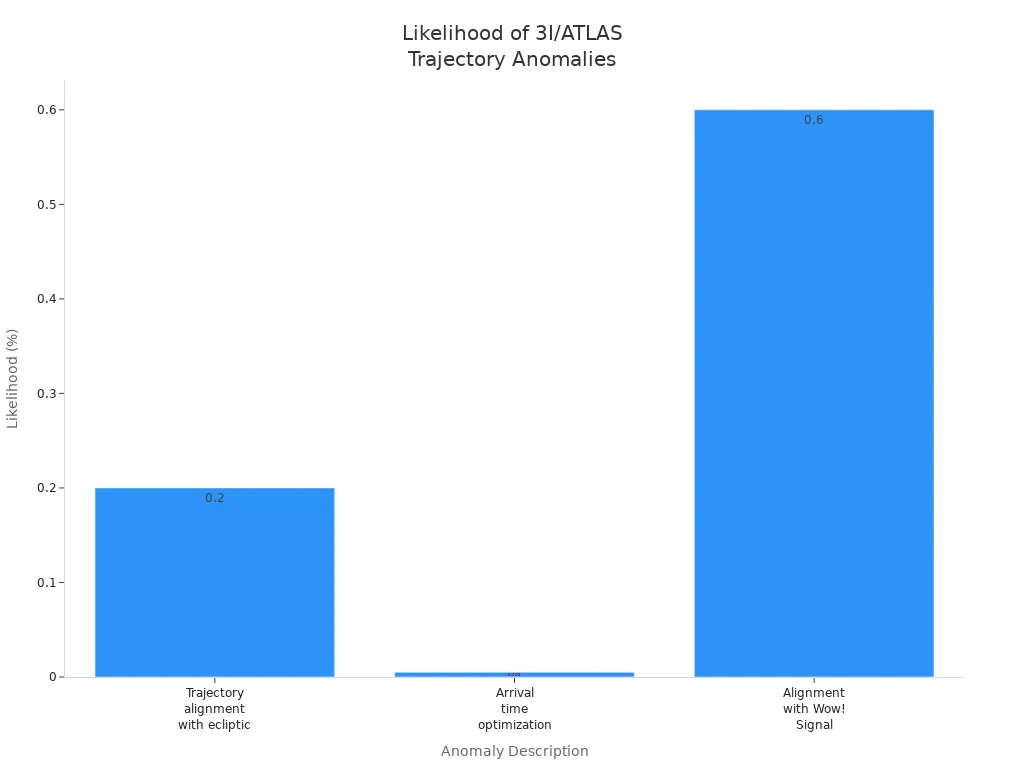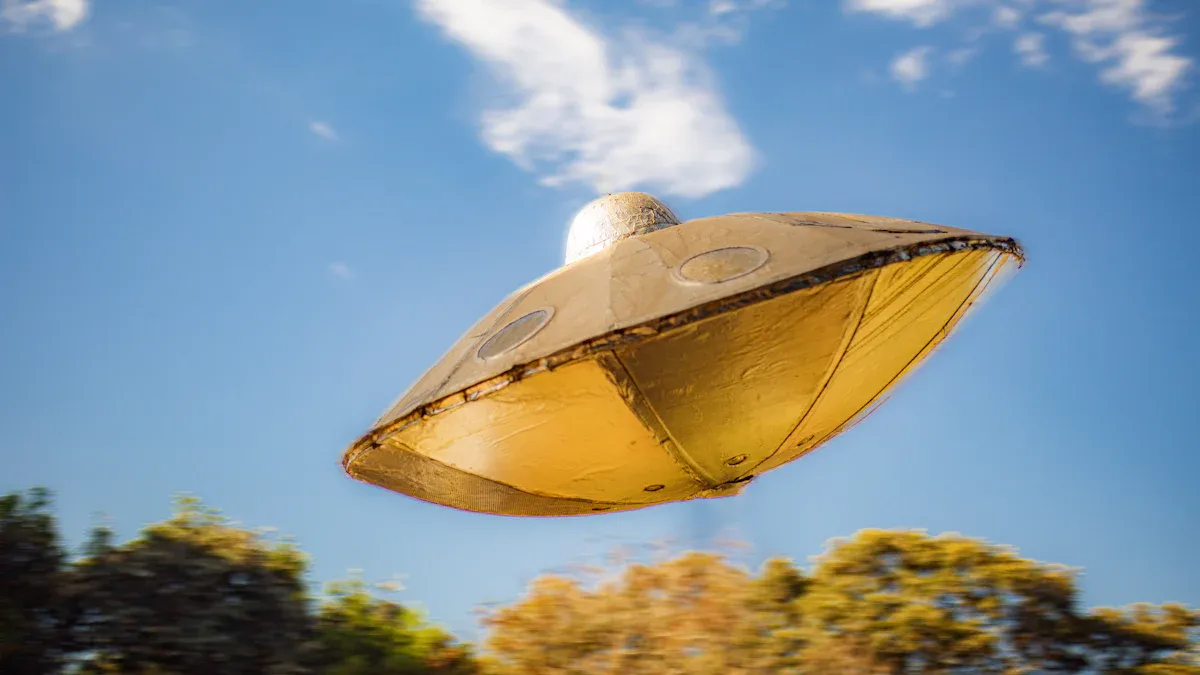The Truth Behind 3I/ATLAS and the Alien Spacecraft Debate

Most scientists think 3I/ATLAS is a comet, not an alien spacecraft. Big telescopes show it behaves like other comets, complete with a tail and gas emissions.
-
Many people discuss what it really is online, especially after comments from Avi Loeb and Elon Musk.
-
Some individuals ponder, "should we be happier?" about these mysteries, while others are simply in search of the truth.
The Guardian reported that people are excited about 3I/ATLAS, drawing comparisons to the historical excitement surrounding discoveries on Mars.
Thinking critically allows us to dismiss wild theories and focus on what the evidence truly indicates.
Key Takeaways
-
3I/ATLAS is thought to be a comet, not an alien ship, because of how it acts and looks. - The object was found on July 1, 2025, with the ATLAS telescope in Chile. It is the third interstellar object ever found. - 3I/ATLAS moves very fast and has a hyperbolic path. This shows it came from outside our solar system. - Scientists saw that 3I/ATLAS has a special chemical makeup. It has more carbon dioxide than water. - The debate about 3I/ATLAS includes ideas from people like Avi Loeb. He thinks it might be alien technology, but most scientists do not agree. - NASA and other experts say we should use the scientific method to check claims about 3I/ATLAS and look at the proof. - More people are interested in 3I/ATLAS because of news stories and what famous people say. This shows we need to think carefully. - Studying interstellar objects like 3I/ATLAS helps scientists learn how comets and planets form in other star systems.
What Is 3I/ATLAS?

Discovery and Name
ATLAS Telescope Find
Scientists saw 3I/ATLAS for the first time on July 1, 2025. They used the ATLAS survey telescope in Río Hurtado, Chile. This telescope looks for objects that might get close to Earth. Astronomers got excited because this object looked different from most comets they knew.
Here’s a quick look at the discovery details:
|
Detail |
Information |
|---|---|
|
Discovery date |
|
|
Discovery location |
Río Hurtado, Chile |
|
Instrument used |
Asteroid Terrestrial-impact Last Alert System (ATLAS) survey telescope |
Meaning of "3I/ATLAS"
The name 3I/ATLAS tells us something special. "3I" means it is the third interstellar object found in our solar system. "ATLAS" is the name of the telescope that found it. Astronomers use this naming style to keep track of rare objects from outside our solar system.
Interstellar Origin
Previous Visitors: 'Oumuamua, Borisov
Before 3I/ATLAS, only two other interstellar objects came here. The first was 'Oumuamua in 2017. The second was comet Borisov in 2019. Both came from far away, beyond our Sun. Each one made scientists ask new questions and feel excited.
Trajectory into Solar System
3I/ATLAS did not begin its trip in our solar system. It moves at about 60 kilometers per second. This fast speed shows it was pushed out of its own star system long ago. Its path does not match the orbits of planets or comets from our solar system. Instead, it follows a hyperbolic path, so it will not come back after it leaves.
Key Features
Size and Mass
Astronomers think 3I/ATLAS is a few kilometers wide. Its mass is hard to know for sure, but it is big enough to see from millions of miles away. The bright coma, which is a cloud of gas and dust, helps scientists study it.
Closest Approaches
3I/ATLAS got closest to the Sun at about four astronomical units (AU). One AU is the distance from Earth to the Sun. Even at this distance, it showed signs of activity. The coma formed when sunlight warmed it, making gases escape.
-
3I/ATLAS is special for a few reasons:
-
Its CO2 to H2O ratio is about 7.6, which is much higher than most comets.
-
It acts like a comet even when far from the Sun.
-
Its fast speed shows it was thrown out of another star system.
-
These things make 3I/ATLAS very interesting for scientists and people who watch the sky.
3I/ATLAS: Comet or Alien Spacecraft?
People everywhere are curious about 3I/ATLAS. Some think it is just a comet. Others wonder if it could be from another world. Let’s see what scientists and regular people are saying.
Scientific Consensus
Most scientists say 3I/ATLAS acts like a comet. They have many reasons for this.
Cometary Tail and Outgassing
Astronomers see a bright tail and a cloud around 3I/ATLAS. This cloud is called a coma. The tail forms when sunlight heats the object. Ice and gas shoot out into space. This is called outgassing. Scientists notice color changes in the coma. These changes happen when chemicals heat up and turn into gas.
-
Scientists point out:
-
Color changes come from chemicals turning into gas.
-
Cold gases might be trapped or from cryovolcanism.
-
Gas jets can change its path, like with ʻOumuamua.
-
3I/ATLAS might be a rare piece of a broken planet.
-
Its chemicals are strange but still fit comet facts.
-
Orbital Path
3I/ATLAS moves on a hyperbolic path. This means it will leave the solar system forever. Its speed and direction show it came from far away. The way it moves matches what scientists expect from an interstellar comet.
Alien Spacecraft Claims
Not everyone thinks 3I/ATLAS is just a comet. Some famous scientists and tech leaders have other ideas.
Avi Loeb’s Hypothesis
Avi Loeb, a Harvard scientist, has a different thought. He says 3I/ATLAS might be more than a comet. He thinks people should not ignore the chance it is alien technology. Loeb points to odd things like its path and speed. These could mean it is artificial.
“Physicist Brian Cox called the alien idea 'drivel.' He says scientists prefer natural explanations.”
Loeb also says the object’s strange movement could mean it uses propulsion. It could be a probe sent to explore space. Still, he admits it is probably a natural comet.
Elon Musk and Public Interest
Elon Musk likes space and has talked about 3I/ATLAS. His tweets and comments make people excited. Many online imagine what if 3I/ATLAS is a spacecraft. The media shares these ideas and makes the debate bigger.
Trajectory Anomalies
Some people who believe the alien idea point to strange things. Here is a table with their main points:
|
Observation |
Description |
|---|---|
|
Change in Angular Momentum |
The change per unit mass is large, which could mean odd behavior. |
|
Maneuvering Evidence |
If 3I/ATLAS moved suddenly, it might be controlled. |
|
Non-Gravitational Acceleration |
Its path changes in ways that could mean propulsion, not just natural forces. |
Other strange facts include its chemicals and how its path matches places in the solar system.
|
Evidence Description |
Details |
Likelihood |
|---|---|---|
|
Unusual chemical composition |
The gas plume had more nickel than iron, like some alloys. |
N/A |
|
Trajectory alignment with ecliptic plane |
The path is within 5 degrees of the ecliptic plane. |
0.2% |
|
Arrival time optimization |
The path passes near Mars, Venus, and Jupiter. |
0.005% |
|
Alignment with the Wow! Signal |
The arrival direction is close to the Wow! Signal from 1977. |
0.6% |

Main Arguments and Counterarguments
The debate has two main sides. Here is what each group says:
-
Some scientists, like Avi Loeb, think the odd path and features could mean it is artificial.
-
Others, like Karen Meech, say the strange things can be explained by comet physics.
-
NASA and SETI checked for signals or signs of technology and found nothing odd.
-
Experts say the nickel vapor and brightness changes match other comets.
-
The object is probably older than the solar system, so it is likely natural.
-
NASA’s Lindley Johnson and the European Space Agency say 3I/ATLAS is not a threat and should be studied.
“Avi Loeb thinks 3I/ATLAS could be artificial. He says its path and features show controlled movement. Karen Meech says the strange things fit comet physics. NASA and SETI say 3I/ATLAS acts like a comet, with no signs of technology. They think it is a natural object.”
Brian Cox calls the alien idea “drivel.” He and many others believe 3I/ATLAS is a cool but natural visitor from another star.
Evidence for a Natural Comet
Observations and Data
Chemical Signatures
Scientists have studied 3I/ATLAS using special tools. They measured the light from the comet. The light showed a red color change of 19% every 100 nanometers between 420 and 700 nm. From 700 to 1000 nm, the color change was only 6% per 100 nanometers. These numbers help scientists know what covers the comet’s surface.
When they checked for gas, they found something odd. The comet did not show strong signs of C2 or CO+ gases. These gases are usually seen in many comets. Even though these gases were missing, the comet still acted like a comet. It let out dust and had a bright coma. The light matched sunlight bouncing off dust, not metal or rock.
-
Scientists found:
-
A lot of water gas, even far from the Sun.
-
No strong lines from CN, C2, NH2, or [O I], which are common in other comets.
Compared to other visitors from space, 3I/ATLAS is different. 'Oumuamua was dry, but Borisov had lots of carbon monoxide. 3I/ATLAS has water vapor and hydroxyl, which makes it special.
NASA and JWST Findings
NASA and the James Webb Space Telescope helped study 3I/ATLAS. NASA’s Neil Gehrels Swift Observatory found water vapor by seeing its hydroxyl byproduct. This happened even when the comet was far from the Sun. Many scientists were surprised by this.
-
NASA and JWST found:
-
Water vapor and hydroxyl gas coming from the comet.
-
A coma with lots of carbon dioxide, showing 3I/ATLAS formed in a cold place.
-
As the comet gets closer to the Sun, more gas and dust come out.
-
These studies matter because 3I/ATLAS will not come back.
-
“The research gives scientists a rare chance to learn about the chemistry of faraway star systems.”
The team used different spacecraft to get data. These missions were not made for 3I/ATLAS, but scientists worked together to learn as much as they could.
Expert Opinions
NASA, Seligman, Lawler
Many experts have talked about 3I/ATLAS. NASA scientists say the coma proves it is letting out gas and dust. They also found chemicals like carbon dioxide and carbon monoxide. These chemicals show 3I/ATLAS has many different materials, just like other comets.
-
Main expert opinions:
-
The coma means the comet is active, which is rare for interstellar objects.
-
The chemicals point to a comet origin.
-
The hyperbolic orbit shows 3I/ATLAS will not return, so scientists watch it closely.
-
Dr. Darryl Seligman and Dr. Sarah Lawler agree the comet acts like a natural object. They see jets of gas and dust push the comet, making small changes in its path. This is normal for comets and does not mean it is artificial.
Comparison to Known Comets
When scientists compare 3I/ATLAS to other comets, they see things that are the same and things that are different. The water vapor and hydroxyl gas are like what they see in many comets. The missing gases, like CN and C2, make 3I/ATLAS a little different. Its bright coma and active jets are what they expect from a natural comet.
|
Feature |
3I/ATLAS |
'Oumuamua |
Borisov |
|---|---|---|---|
|
Water vapor |
Detected |
Not detected |
Not detected |
|
Carbon monoxide |
Some evidence |
Not detected |
Rich |
|
Coma |
Bright, active |
None |
Active |
|
Orbit |
Hyperbolic |
Hyperbolic |
Hyperbolic |
Scientists think 3I/ATLAS is a natural comet. Its chemistry, actions, and path all show it is natural, even if some things about it are special.
The Alien Spacecraft Debate

Loeb’s Arguments on 3I/ATLAS
Reconnaissance Probe Theory
Avi Loeb is a Harvard astrophysicist. He has made people talk about 3I/ATLAS. He thinks there is a real chance it is not just a comet. Loeb talks about a reconnaissance probe. This means something sent by an advanced group to study other stars. He points out some strange things about 3I/ATLAS.
-
Loeb says there is a 30-40% chance it is not natural.
-
He lists seven odd things that could mean it is technology.
-
He talks about a "black swan" event. This is when a probe looks like a normal comet to hide.
Loeb’s idea makes people think. He wants scientists to stay open-minded and notice strange details. If 3I/ATLAS is a hidden probe, it could change how we see our place in space.
Loeb Scale and Risk
Loeb also talks about risk. He uses the "Loeb Scale" to decide how much attention strange objects need. The scale checks the chance an object is artificial and what would happen if it is true. Loeb says even a small chance is worth studying. The discovery would be very important.
Public and Media Response
Elon Musk’s Comments
Elon Musk is the CEO of SpaceX. He joined the debate about 3I/ATLAS. He talked about it on The Joe Rogan Experience. Musk shared his thoughts about its size and what could happen if it hit Earth. He also talked about ideas that it might not be natural. Musk said that having nickel does not mean it is a spacecraft. His words show how experts can shape what people think.
-
Musk asked questions about the comet’s size and what it is made of.
-
He explained that nickel in 3I/ATLAS does not prove it is a spacecraft.
-
His ideas help guide what people wonder about space.
Media Sensationalism
The media likes a good mystery. News and social media have talked a lot about the debate between Loeb and NASA. This made the story even bigger. Some famous people, like Kim Kardashian, posted about 3I/ATLAS. NASA had to tell everyone the comet is not dangerous.
Here is how people and the media reacted:
|
Aspect |
Description |
|---|---|
|
Public Curiosity |
The debate made people wonder if 3I/ATLAS could be alien technology. |
|
Skepticism |
Many people do not believe Avi Loeb’s ideas. They talk about this on Reddit and other sites. |
|
Media Coverage |
The news has talked a lot about the different views of Loeb and NASA. This shows the controversy. |
|
Scientific Discourse Impact |
The debate made people talk more about life outside Earth. It made some scientists question old ideas. |
Media stories can make science debates seem bigger. Sometimes, they make people ask big questions about life in space. Other times, they cause confusion or worry. The story of 3I/ATLAS shows how science, celebrities, and news can mix and change what people think.
Science vs. Speculation
Weighing the Evidence
Addressing Anomalies
Some people see strange things about 3I/ATLAS. They say it does not always act like other comets. Scientists saw it speed up in ways gravity cannot explain. This is called "non-gravitational acceleration." The object moved in two odd ways—one away from the Sun and one sideways. When it got closer to the Sun, 3I/ATLAS became brighter and looked more blue. Most comets look redder near the Sun. Another surprise was a jet of particles pointing toward the Sun, not away. Some people noticed 3I/ATLAS passed close to Jupiter, Venus, and Mars. These facts made some wonder if it could be a probe from another world.
Scientists studied these strange features. They explained that jets of gas and dust can push a comet in odd ways. Sunlight heats up different parts, making it move in new directions. The blue color might come from special chemicals on the surface. These things are unusual, but they do not prove 3I/ATLAS is a spacecraft.
Why Science Favors a Comet
Most scientists think 3I/ATLAS acts like a comet. They see signs that match what comets do:
-
When 3I/ATLAS gets closer to the Sun, it lets out gases. Sunlight heats up the ice and dust.
-
A cloud of gas and dust forms around it. This is a classic sign of a comet.
-
The features seen by telescopes match natural comets. If 3I/ATLAS were artificial, it would look very different.
These facts make the comet idea much stronger than the spacecraft idea.
Critical Thinking
Scientific Method
The scientific method helps people tell wild ideas from real evidence. Scientists test their ideas many times. They use data they can see and measure. This careful process keeps science honest. For 3I/ATLAS, researchers use the scientific method to check every claim. They look for proof before making big statements. This way, curiosity stays alive but wild guesses are stopped.
-
The scientific method means testing ideas with real data.
-
Scientists stay curious but also careful.
-
The 3I/ATLAS debate shows why research based on evidence matters more than guesses.
Healthy Skepticism
Good science needs healthy skepticism. This means asking questions and not believing every wild story. When people hear about alien spacecraft, they should look for strong proof. Scientists use key ideas when they study strange objects like 3I/ATLAS:
|
Principle |
Explanation |
|---|---|
|
Skepticism |
Scientists ask tough questions about big claims. |
|
Extraordinary evidence for extraordinary claims |
Big ideas need strong proof before people accept them. |
|
Consideration of alternative explanations |
Scientists look for other reasons before choosing the wildest answer. |
|
Scientific method's role |
Testing and checking ideas keeps science strong. |
|
Resistance to extraordinary claims |
Science moves slowly when new ideas appear, making sure they are true. |
|
Reluctance to consider extraterrestrial intelligence |
Scientists want very strong evidence before saying aliens exist. |
|
Resource allocation for extraterrestrial studies |
Scientists think carefully before spending lots of money on wild ideas. |
|
Transparency and collaboration |
Sharing results helps science, but some things must stay private. |
|
Bias in data interpretation |
Many scientists check the same data to avoid mistakes. |
Using these ideas helps people enjoy space mysteries while staying focused on facts.
Lessons from 3I/ATLAS
Interstellar Insights
What We Learn
3I/ATLAS has helped scientists learn new things about space. When they looked at this comet, they saw it has a lot of carbon dioxide. This means it probably formed in a very cold place, far from its star. Scientists now see that comets can form in many ways, based on where they start. This finding helps everyone know more about how planets and comets form in other solar systems. Each new interstellar object gives us a new way to look at the universe and how it works.
Note: Every time a comet like 3I/ATLAS comes by, scientists get a rare chance to study stuff from another star system. These objects are like messengers, bringing clues about places people may never see.
Future Research
Researchers want to learn even more from interstellar objects. They have made some clear goals for the future. Here is a table that shows what they want to find out:
|
Objective |
Description |
|---|---|
|
Physical Properties |
Scientists want to measure size, shape, and mass to learn how the object formed and changed. |
|
Composition |
They plan to study what the comet is made of. This helps explain where it came from and what happened to it over time. |
|
Coma Investigation |
Experts will look closely at the cloud of gas and dust around the comet. They want to know how it escapes from the center. |
By looking at these things, scientists hope to answer big questions about where comets come from and the history of other solar systems.
Public Discourse
Navigating Claims
The story of 3I/ATLAS shows why it is important to think before believing big claims. NASA’s research shows that even if a comet looks strange, it does not always mean danger or aliens. People need to check the facts and not just believe rumors. The debate about 3I/ATLAS reminds everyone to check where information comes from and to ask questions before sharing stories.
-
NASA’s findings show 3I/ATLAS is not a threat, which shows why science is better than wild guesses.
-
The excitement about the comet made people talk more about how to spot fake news and avoid being fooled by flashy headlines.
Science Communication
Famous people like Elon Musk made the 3I/ATLAS debate even more popular. Their comments make people curious and sometimes lead to wild ideas about aliens. This shows how fast stories can spread, especially when the media gets involved. Sometimes, these stories mix facts with made-up things, making it hard to know what is true.
-
People got more interested in 3I/ATLAS because of big names and social media.
-
The mix of real science and wild ideas shows why everyone should think for themselves.
-
Trust in science grows when people see clear and honest communication.
Tip: When reading about space or science, look for information from trusted sources. Ask questions, stay curious, and remember that science is about finding the truth, not just telling exciting stories.
Most scientists say 3I/ATLAS is a real comet. Hubble and JWST saw its icy dust and special chemicals. These things show it came from another star system. But some people still talk about aliens. Avi Loeb and news stories make people wonder. It is good to be curious, but science needs strong evidence. NASA’s Michelle Thaller says science should start with natural ideas. 🪐 The most amazing thing is what these space visitors teach us about how worlds are made everywhere in the universe.
FAQ
What is 3I/ATLAS?
3I/ATLAS is a comet from another star system. Scientists found it in 2025 with the ATLAS telescope in Chile. It does not come from our solar system.
Why do some people think 3I/ATLAS is an alien spacecraft?
A few experts, like Avi Loeb, saw odd things about it. Its path and speed are different. Elon Musk and news stories made more people interested.
How do scientists know 3I/ATLAS is a comet?
Scientists see a bright cloud and a tail around it. Gas and dust come out when sunlight warms the comet. Its chemicals are like those in other comets.
Did NASA or JWST find anything unusual about 3I/ATLAS?
NASA and JWST found water vapor and carbon dioxide. These chemicals mean it came from a cold place. They did not find any signs of alien technology.
Has 3I/ATLAS ever posed a threat to Earth?
No, 3I/ATLAS never got close enough to hurt Earth. NASA and the European Space Agency say it is safe.
What makes 3I/ATLAS different from other comets?
3I/ATLAS has more carbon dioxide than most comets. Its chemicals are special. It moves faster and follows a path that will not bring it back.
Why is it important to study interstellar objects like 3I/ATLAS?
Studying these objects helps scientists learn about other star systems. Each one gives new clues about how planets and comets form in space.





